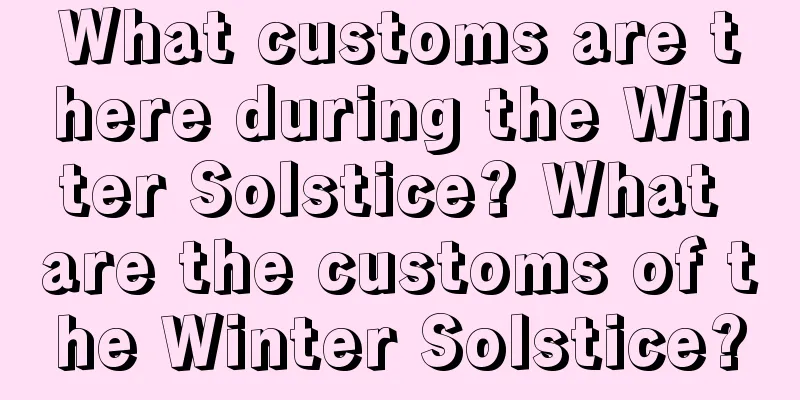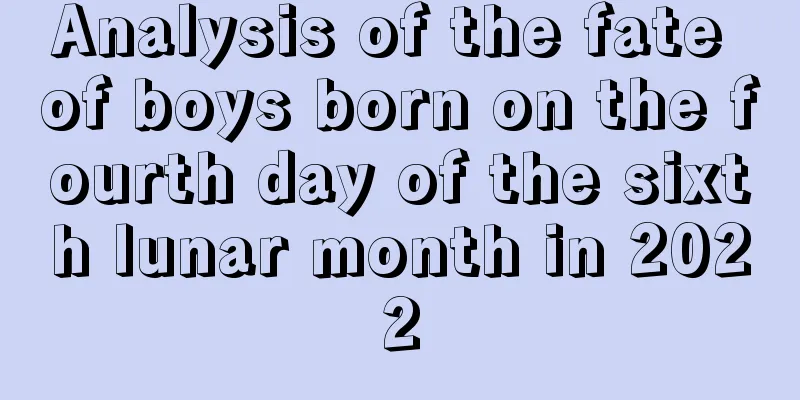What customs are there during the Winter Solstice? What are the customs of the Winter Solstice?

The Winter Solstice is a very important solar term in the Chinese lunar calendar and also a traditional festival of the Han ethnic group in my country. So, do you know what customs there are during the Winter Solstice? What are the customs of the Winter Solstice? The eleventh month of the lunar calendar is a new month. What should we do and what should we avoid in this new month? Visit Shui Mo Xiansheng's website to learn more about the eleventh month of the lunar calendar.Winter Solstice Customs:1. Worship the Heaven and Ancestors <br /> Since the Zhou Dynasty, there have been sacrificial activities on the winter solstice. "The Book of Zhou: Spring Officials, Divine Officials" states: "On the winter solstice, worship the gods and ghosts." On this day, many places will worship their ancestors. Even the poorest families will use their savings to buy new clothes and prepare sacrificial items.2. Counting the Nines <br /> People call the winter solstice "Jiaojiu" or "Counting the Nines", which means starting from the winter solstice, every nine days is a "nine", a total of 9 "nine", a total of 81 days, and spring will come after 81 days. After the winter solstice, counting the nine-nine days has become very popular all over the country. People in different regions have compiled various proverbs and rhymes about counting the nine-nine days according to different climatic conditions, scenic features, agricultural phases and customs. The most representative one is the following one: The first and second nine-nine days are not out of place, the third and fourth nine-nine days are walking on the ice, the fifth and sixth nine-nine days are watching the willows along the river, the seventh nine-nine days the river opens, the eighth nine-nine days the wild geese come, the ninth nine-nine plus one-nine days, oxen are walking everywhere. 3. Sticking round balls on the door <br /> In southern Fujian and Chaoshan, during the winter solstice, people roll two large round balls and stick them on the door ring, symbolizing reunion and good luck. This custom originated from a folk legend: On the winter solstice of one year, an old beggar had no money to bury his wife who had frozen to death, so he had to sell his daughter to a rich family as a slave. The daughter was in so much pain that she fainted. The old beggar quickly begged for a bowl of rice soup and fed it to his daughter mouthful by mouthful. Slowly, his daughter finally woke up. The old beggar got a few more glutinous rice balls for his daughter and comforted her: "We are separated today, just like these dumplings split into two halves. Now we each eat half, and when life is better in the future and we are reunited, we can eat the dumplings again." After that, the old beggar said goodbye to his daughter, buried his wife, and went on to beg again. Three years passed, and the old beggar still did not come back to find his daughter. His daughter missed her father and hoped that they could be reunited soon. During the winter solstice festival one year, she came up with an idea and suggested to her owner: "Everyone eats glutinous rice balls during the winter solstice, so we should also offer them to the door gods." The owner agreed, and she rolled two large glutinous rice balls and stuck them on the door knocker to express her longing for her father. Her filial piety moved later generations, and it became a custom that has been passed down to this day. 4. Eating dumplings <br /> In northern China, there is a custom of eating dumplings on the winter solstice of the lunar calendar every year. As the saying goes, "On October 1st, the winter solstice arrives, and every household eats dumplings." This winter solstice custom is to commemorate the "medical saint" Zhang Zhongjing who gave away medicine on the winter solstice. During the Eastern Han Dynasty, Zhang Zhongjing resigned from his official position and returned to his hometown to treat his neighbors. It was winter, with heavy snow and very cold. The people on both sides of the Baihe River were pale and thin, suffering from hunger and cold, and many people's ears were frostbitten. When Zhang Zhongjing saw this, he asked his disciples to build a medical tent at the East Gate of Nanyang. On the day of the winter solstice, he put mutton, chili peppers and some cold-relieving herbs in a pot and boiled them with water. Then he took out the mutton and herbs, chopped them up, and used bread to make them like ears. After being cooked, two "Jiao'er" and a large bowl of broth were given to each person who came to ask for medicine. After eating the "Jiao'er" and drinking the "Cold-Removing Soup", people felt warm all over, their ears became hot, and their frostbitten ears were cured. Later generations learned the shape of "Jiao'er" and wrapped them into food, also called "dumplings" or "bianshi". Therefore, the custom of eating dumplings to prevent frozen ears during the winter solstice has been passed down. 5. Eating glutinous rice balls <br /> Eating glutinous rice balls is also a traditional custom of the winter solstice, especially popular in the south of the Yangtze River. "Tangyuan" is a must-have food during the Winter Solstice. It is a round dessert made from glutinous rice flour. "Round" means "reunion" and "perfection". Eating tangyuan during the Winter Solstice is also called "Winter Solstice Balls". There is a saying among the people that "eating glutinous rice balls makes you one year older." The winter solstice dumplings can be used to worship ancestors or given as gifts to friends and relatives. In the old days, Shanghai people were most particular about eating tangyuan. There is an ancient poem that goes: "Every family is pounding rice to make dumplings, knowing that tomorrow is the winter solstice." 6. Eat red bean glutinous rice <br /> In the Jiangnan area, people have the custom of cooking and eating red bean rice on the day of the winter solstice. Legend has it that Gonggong had an incompetent son who committed many evil deeds and died on the winter solstice. After his death, he turned into a plague ghost and continued to harm the people. However, this plague ghost is most afraid of red beans, so people gather together as a family on the night of the winter solstice to eat red bean glutinous rice to ward off the plague ghost and prevent disasters and diseases. 7. Eat Nine-layer Cake <br /> In Taiwan, the tradition of using nine-layer cake to worship ancestors during the winter solstice is still preserved. Glutinous rice flour is used to shape chickens, ducks, turtles, pigs, cows, sheep and other animals that symbolize good luck, fortune, longevity and happiness. Then, they are steamed in layers in a steamer and used to worship ancestors to show that they have not forgotten their ancestors. People of the same surname and clan gather at the ancestral temple on the winter solstice or on an agreed-upon date before or after it, and worship their ancestors one by one according to the order of seniority. This is commonly known as "ancestor worship." After the ceremony, a grand banquet will be held to entertain relatives who come to worship their ancestors. Everyone drinks heartily and reconnects with each other after a long separation, which is called "eating ancestors." The Winter Solstice Festival has been passed down from generation to generation in Taiwan to show that people have not forgotten their "roots." 8. Giving Shoes as Gifts <br /> During the winter solstice, people have the custom of giving shoes as gifts. It is said in "China Past and Present": "In the Han Dynasty, there were embroidered mandarin duck shoes. Emperor Zhao ordered them to be presented to uncles and aunts on the winter solstice." As time went by, the custom of giving shoes to uncles and aunts gradually evolved into uncles and aunts giving shoes and hats to nephews and nieces. In ancient times, hand-embroidered shoes given to women were mostly embroidered with flowers and birds, and hats were mostly made in the shape of phoenixes; shoes given to men were mostly embroidered with ferocious beasts, and hats were mostly made in the shape of tigers. 9. Offering socks and shoes <br /> In ancient times, women offered shoes and socks to their parents-in-law on the winter solstice. The Later Tang Dynasty's "Notes on China's Past and Present" stated: "In the Han Dynasty, there were embroidered mandarin duck shoes. Emperor Zhao ordered them to be presented to their uncles and aunts on the winter solstice." Since then, it has become a custom for women to present socks and shoes to their parents-in-law on the winter solstice. In the old days, this custom was popular in both the north and the south. It probably meant for women to try out their needlework and wish their elders a long life. What Du Fu said in his poem "embroidery of five patterns with added weak threads" refers to the process of women making shoes and socks. In the poem "A Girl Presents Socks" by Cui Hao of the Northern Wei Dynasty, the significance of this custom was described very accurately: "The yang is born below, the sun is eternal in the sky, and the long-lasting blessings will last for hundreds of millions of years." Therefore, in the past, the winter solstice was also called the Winter Solstice Festival. 10. Cellar Flowers <br /> In late winter and early spring, flower markets often use cellar storage technology to make flowers bloom early, such as peonies, peonies, peach trees, magnolias, etc. At this time, they can be trimmed into bonsai and sold for people to decorate the New Year. They are commonly known as Tang flowers. Because fire is used to heat the air and promote the flowers to bloom, the flowering period is not long. During the Song Dynasty, the Tang flowers sold by Ma Mu in Hangzhou were the most famous. After winter, people in Beijing would dig cellars in the ground, use flames to smoke the soil, plant flowers, fruits and melons in the cellars, and water them frequently to promote their growth. Even in the dead of winter, all vegetables and fruits are still available. 11. Storing Winter Ice <br /> In the north, people usually build cellars to store ice around the winter solstice. People use iron rods to chisel ice from the river. A piece of ice that is more than one foot wide and two feet long is called a square. On the winter solstice, the ice is stored in cellars. The cellar is about two feet deep. After the ice is stored, the cellar is immediately sealed tightly. At the same time, various fresh fruits are stored in the cellar. After spring, they are taken out and sold in the market. The color is as if they were just picked from the tree. Residents along the southern coast usually repair their ice cellars and store ice after the winter solstice to keep the fish fresh during the next year's fishing season. |
Recommend
Recommended auspicious days for picking up a car around Grain Full in 2020. What should you not do on Grain Full in 2020?
Introduction: It is also necessary to choose an au...
Are the people who died on Labor Day 2020 okay? Is Labor Day 2020 an auspicious day for funerals?
Introduction: An auspicious day must be chosen for...
How to check the location of the God of Wealth on the eighth day of the third lunar month in 2019?
March in the lunar calendar is the third month of...
What about the third day of the twelfth lunar month in 2017? Can we sign the contract?
Introduction: Signing a contract is very important...
What date is August 9, 2019, and what is the day like?
In many cases in daily life, we need to use the l...
Is it a good idea to get married on November 25th of the lunar calendar in 2020? Are there any taboos in marriage?
The arrival of the eleventh month of the lunar ca...
Is it good for people born in the twelfth month of the lunar calendar? The most auspicious birth month for Monkeys
People born in the year of the monkey are clever a...
Analysis of the fate of boys born on Mother's Day in 2020. Is the boy's fate good?
The fate of boys born every day is different. So, ...
When is the Spring Equinox in 2017? What do the three phases of the Spring Equinox refer to?
Introduction: The 24 solar terms were summarized b...
What date in the Gregorian calendar is April 24, 2019 suitable for traveling?
What date is April 20th of the lunar calendar in 2...
What zodiac sign is born on Dragon Boat Festival in 2022? What is the personality of a child born on the Dragon Boat Festival?
The Dragon Boat Festival is here, and the aroma of...
Is it suitable to get a haircut in the beginning of autumn in 2018? What is the Beginning of Autumn?
Although getting a haircut is a common thing nowad...
Can I move some things in before moving? Can you come into the house empty-handed?
If you don’t pay attention to the Feng Shui when m...
The most auspicious days for girls to be born in June of the lunar calendar in 2019!
Which days in the sixth lunar month of 2019 are su...
Is June 16, 2019, Father’s Day a suitable day for opening a business? Is it a good idea to open a business on Father’s Day?
Introduction: Opening a business is an important e...









